Castles in England: Explore England’s Most Iconic Castles & Historic Fortresses
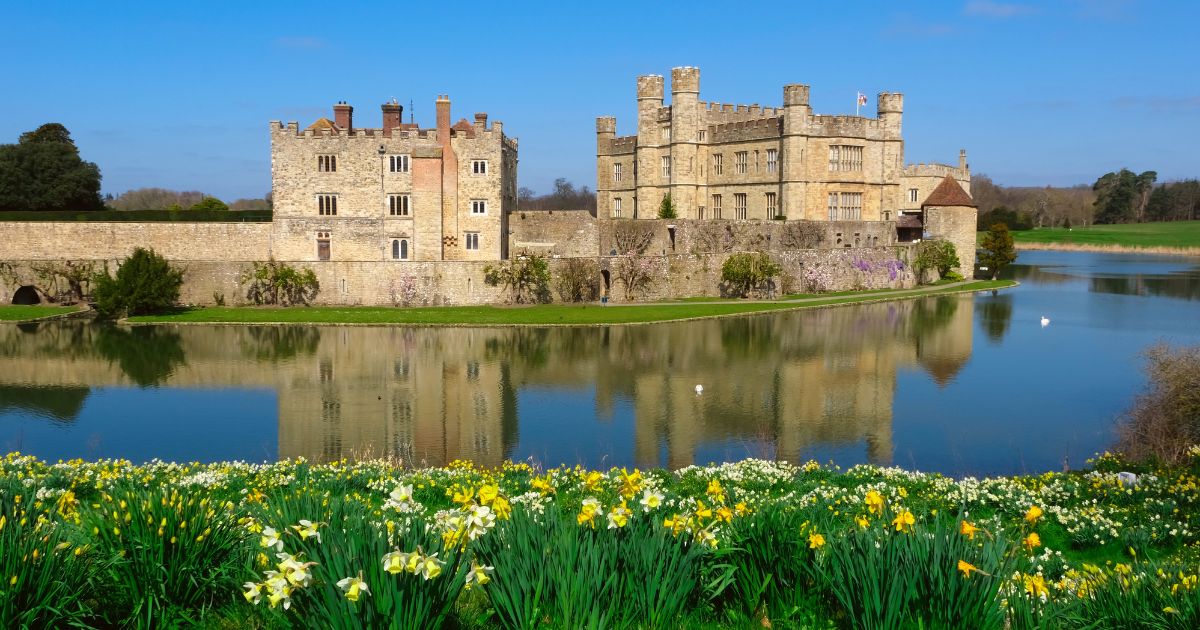
Castles in England are some of the most recognizable in the world – from mighty medieval fortresses guarding windswept coastlines to royal palaces shaped by centuries of monarchy. These extraordinary structures reveal England’s turbulent past, architectural evolution, and deep cultural heritage. Whether you’re exploring Norman keeps, Tudor palaces, Victorian restorations, or cinematic cliffside ruins, England’s castles offer an unforgettable journey through a thousand years of history.
This guide explores the most iconic castles in England, the eras that shaped them, the regions where they flourish, and practical tips for planning your castle-filled adventure.
Key Takeaways
- England’s castles reflect 900+ years of history, from Norman conquest fortifications to Tudor palaces and Gothic revival showpieces.
- Major regions include Northumberland (fortresses), Kent (royal favorites), Yorkshire (medieval power centers), and the Cotswolds (romantic ruins).
- Many castles now host exhibitions, gardens, falconry shows, and seasonal events.
- Top sites include Tower of London, Windsor Castle, Warwick Castle, Leeds Castle, Alnwick Castle, and Dover Castle.
- Visitors can expect diverse experiences – from secret tunnels and armories to manicured gardens and medieval reenactments.
Historical Overview of Castles in England
England’s castle-building tradition began with the Norman Conquest in 1066, when William the Conqueror introduced motte-and-bailey fortifications across the country to secure strategic control. As power consolidated, wooden palisades evolved into massive stone keeps – iconic symbols of feudal authority.
Throughout the medieval period, castles became more sophisticated: curtain walls strengthened with towers, complex gatehouses defended by murder holes and portcullises, and concentric defenses revolutionized siege resistance. By the 14th and 15th centuries, domestic comforts increased as military threats shifted, blending fortified strength with aristocratic luxury.
The Tudors transformed fortifications into palatial residences, while the Victorians revived medieval aesthetics with romantic restorations. Today, England’s castles remain some of the most diverse in all of Europe – each one a layered story of conquest, monarchy, rebellion, and reinvention.
Notable Eras & Architectural Evolution
England’s castles evolved dramatically over the centuries, shaped by invasions, royal power struggles, shifting architectural ideals, and advances in warfare. Each era left distinct features that travelers can still admire today.
Norman Conquest & Motte-and-Bailey Beginnings (11th Century)
After the Norman invasion of 1066, William the Conqueror ordered the rapid construction of hundreds of motte-and-bailey castles across England. These early fortifications featured a wooden keep perched on an artificial mound (the motte) and a fenced courtyard (the bailey). Though simple, they allowed Norman forces to control key towns and roads. Many were later rebuilt in stone, giving rise to England’s first great medieval strongholds.
Stone Keeps & Royal Power Consolidation (12th Century)
The transition from timber to stone brought permanence – and intimidation. Massive square keeps became symbols of royal authority, often rising above bustling market towns. Castles like the White Tower in London or Rochester Castle displayed thick defensive walls, narrow windows, and limited entrances designed to withstand prolonged sieges. These stone giants remain some of England’s most impressive medieval structures.
High Medieval Curtain Walls & Defensive Innovation (13th–14th Centuries)
By the 1200s, English castle design shifted toward more advanced and layered defenses. This era introduced:
- Concentric walls (multiple defensive rings)
- Round towers to eliminate blind spots
- Gatehouses reinforced with portcullises and murder holes
- Moats for added protection
Castles like Dover, Kenilworth, and Framlingham exemplify these innovations. Siege warfare had become more sophisticated, and England’s fortifications evolved accordingly.
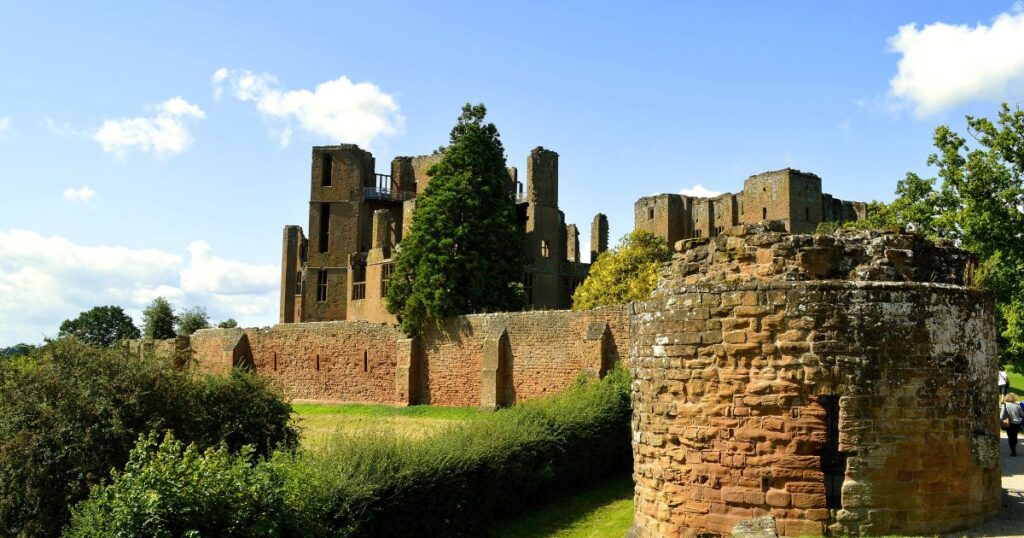
Late Medieval Comfort & Palace-Fortress Hybrids (14th–15th Centuries)
As military threats decreased, many castles began serving dual roles: fortified residences and luxurious homes for nobility. Architecture shifted to include large windows, comfortable great halls, gardens, and decorative stonework. Leeds Castle, Warwick Castle, and Bodiam Castle showcase this blend of defense and domesticity – technically fortified, yet undeniably elegant.
Tudor Era & the Decline of Medieval Fortification (16th Century)
Gunpowder weapons changed everything. Traditional medieval walls could not withstand cannon fire, so castle architecture pivoted dramatically. Under Henry VIII, England constructed a network of Device Forts (coastal artillery forts) with low, thick, angled walls capable of absorbing cannon blasts. The most famous Tudor-era residence is Hampton Court Palace, Henry VIII’s favorite royal home. Other key Tudor-era fortifications include Deal Castle and Pendennis Castle.

Elizabethan Era: The Rise of Prodigy Houses (Late 16th Century)
By the late 1500s, fortified castles had largely lost their military function, giving rise to an entirely new architectural phenomenon: the Elizabethan prodigy house. These grand, theatrical residences were built by wealthy nobles eager to display loyalty, status, and cultural sophistication during Queen Elizabeth I’s reign.
Instead of moats, battlements, and arrow slits, these new houses emphasized symmetry, verticality, and ornate Renaissance-inspired detailing. Hallmarks of the era include:
- Tall, glass-filled façades designed to impress (glass was a major luxury)
- Elaborate E- or H-shaped floor plans referencing royal symbolism
- Grand long galleries for entertaining, art display, and indoor walking
- Decorative parapets, turrets, and strapwork ornamentation
- Expansive landscaped parks replacing defensive perimeters
Examples: Hardwick Hall (“more glass than wall”), Burghley House, and Longleat embody the showmanship and architectural ambition of the Elizabethan aristocracy.
This era marks the complete transformation of England’s castles from military strongholds into luxurious country houses – an evolution driven by peace, prosperity, and the performance of power.
Stately Homes, Baroque Splendor & Gothic Revival (17th–19th Centuries)
Castles were no longer built for war but for prestige. England’s aristocracy transformed or replaced medieval castles with grand country estates. Later, the 19th-century Gothic Revival rekindled enthusiasm for medieval aesthetics, leading to romantic reconstructions – like Arundel Castle’s dramatic makeover — that blended fantasy with history. Many of today’s castle interiors, gardens, and façades reflect these later reinterpretations rather than medieval origins.
Architectural Styles & Design Elements in English Castles
England’s castles and palace-fortresses reveal nearly a thousand years of evolving architectural styles. From stark Norman keeps to lavish Tudor palaces and Victorian-era romantic rebuilds, each period added distinctive forms, materials, and innovations that shaped the English castle landscape.
Norman Motte-and-Bailey & Early Stone Keeps
Early Norman castles began as wooden keeps perched atop artificial mounds (mottes), paired with enclosed courtyards (baileys). As England stabilized under Norman rule, timber structures were replaced with massive stone keeps – the classic square Norman tower built for authority and defense. Key features include:
- Thick masonry walls
- Narrow slit windows
- High entrance doors accessed by removable wooden stairs
- Extremely limited domestic comfort
Examples: The White Tower at the Tower of London is the defining model – a stark, towering stone block built to intimidate and control the capital.
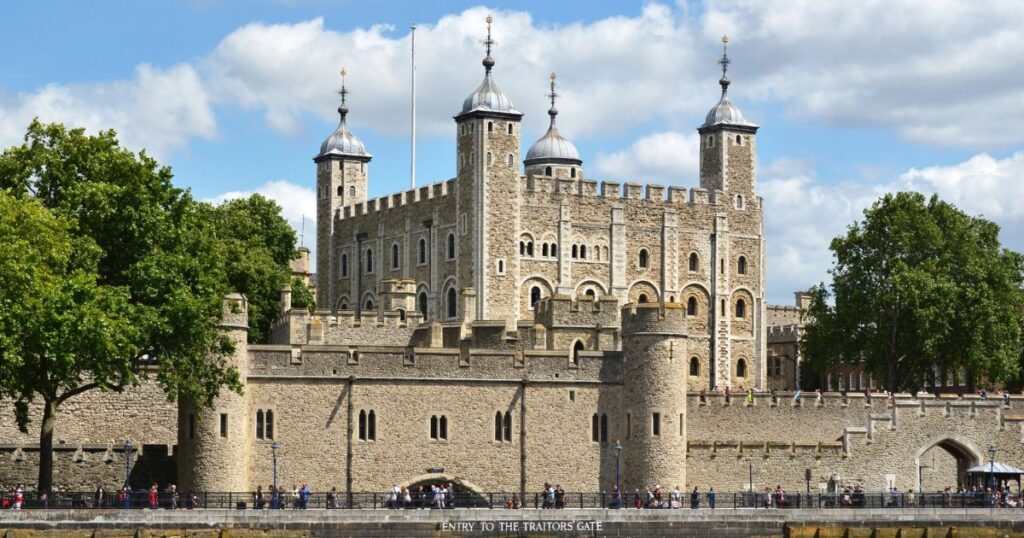
Medieval Concentric Defenses & Curtain Walls
By the 13th century, England’s castles incorporated more sophisticated defensive innovations. Military engineering and architectural creativity merged to produce fortresses designed to withstand large-scale siege warfare. Characteristic elements include:
- Concentric rings of defensive walls
- Rounded mural towers to eliminate blind spots
- Deep moats or water defenses
- Heavily fortified gatehouses
Examples: Dover Castle, Kenilworth Castle – both demonstrate layered walls and overlapping defensive fields.
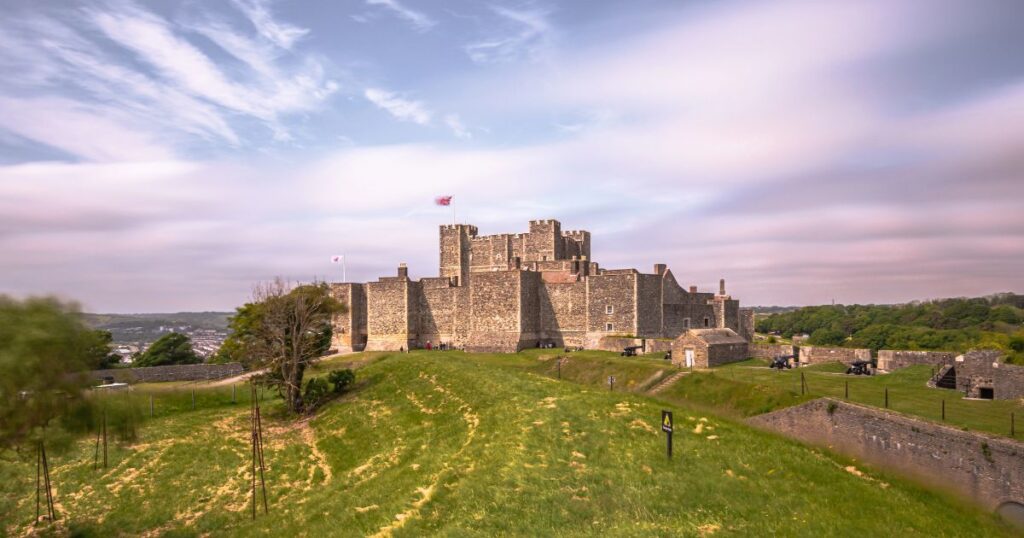
Moated Castles & Picturesque Medieval Residence Design
From the 12th century onward, many English castles incorporated moats—not just for defense, but also as a visual display of wealth and power. Water barriers slowed attackers, protected foundations, and added a dramatic sense of separation between the noble household and the outside world. Key features include:
- Broad, water-filled moats (natural or engineered)
- Stone bridges or later drawbridges providing controlled entry
- Defensive towers positioned to overlook the water
- Compact inner wards designed for both residence and protection
Examples: Bodiam Castle and Hever Castle remain two of the finest moated castles in England, their mirrored reflections in the water reinforcing both beauty and defensive purpose.
Tudor Palaces & Early Modern Redesign
By the 16th century, England’s castles shifted decisively from military fortresses to grand palatial residences. The Tudor period emphasized comfort, ceremony, and political theater, creating architectural spaces designed to impress ambassadors and house the expanding royal court. Key features include:
- Ornate brick façades with decorative chimneys
- Great halls used for feasts, audiences, and royal pageantry
- Privy chambers offering unprecedented levels of privacy
- Elaborate gardens and enclosed courtyards reflecting Renaissance influence
Examples: Hampton Court Palace and the restored wings of Windsor Castle showcase this transition beautifully, blending royal grandeur with evolving ideas of domestic luxury.
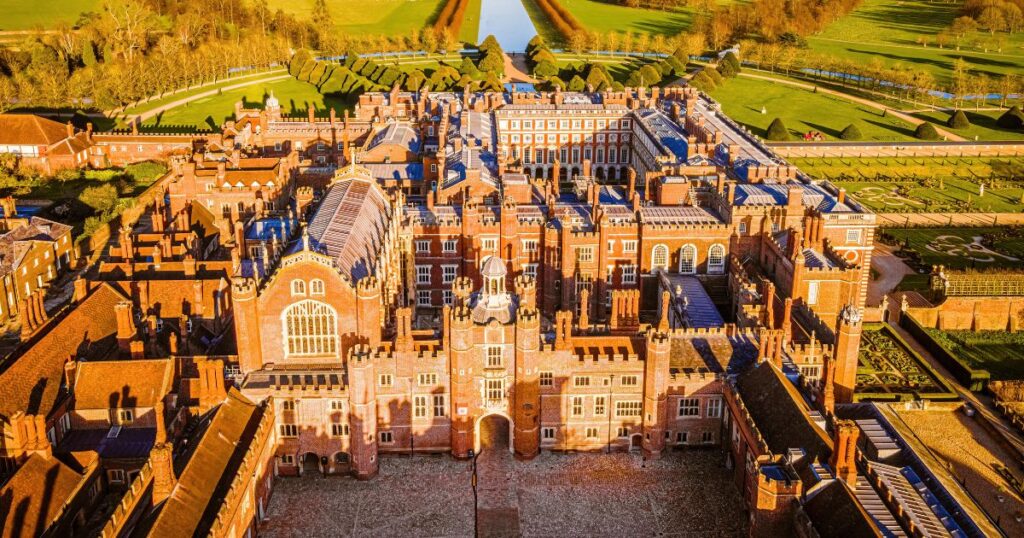
Device Forts: England’s Gunpowder Age Fortifications
In the mid-16th century, Henry VIII ordered a chain of powerful coastal forts – known as Device Forts – to defend England from potential invasion by France and the Holy Roman Empire. These were among the earliest English fortifications designed specifically for heavy artillery rather than archers. Key features include:
- Low, thick stone walls engineered to absorb cannon fire
- Angular bastions allowing cross-fire along the coastline
- Gun platforms positioned for both sea and land defense
- Symmetrical geometric plans optimized for artillery warfare
Examples: Deal Castle, Walmer Castle, and St. Mawes Castle are superb surviving examples, showcasing England’s shift toward early modern military engineering.
Elizabethan Showhouses & the Rise of the Prodigy House
By the late 16th century, England entered a new architectural age defined not by war, but by wealth, stability, and the desire to impress foreign dignitaries. The aristocracy built vast “prodigy houses” – spectacular showpiece residences designed to display power, sophistication, and artistic taste. These grand estates bridge the gap between fortified castles and the later country-house tradition. Characteristic features include:
- Enormous mullioned windows that signaled wealth (“more glass than wall”)
- Symmetrical floor plans with long gallery rooms for display and entertainment
- Ornate parapets, turrets, and decorative rooftop silhouettes
- Rich interior plasterwork, tapestries, and carved woodwork
Examples: Hardwick Hall, Longleat, and Burghley House epitomize the Elizabethan era’s emphasis on grandeur, display, and domestic luxury.
Gothic Revival & 19th-Century Romantic Reimagining
During the 19th century, a wave of romantic medievalism swept across England, inspiring architects to revive (and often reinvent) the Gothic style. These sites were not defensive but artistic – lavish interpretations of what people imagined medieval castles should look like. Key elements include:
- Pointed arches, battlements, and decorative tracery
- Romanticized silhouettes with towers, turrets, and castellated rooflines
- Interiors inspired by medieval halls and chapels
- Emphasis on drama, nostalgia, and aesthetic fantasy
Examples: Highclere Castle (famous as Downton Abbey), Arundel Castle restorations, and Strawberry Hill House represent this imaginative era of revival and reinvention.
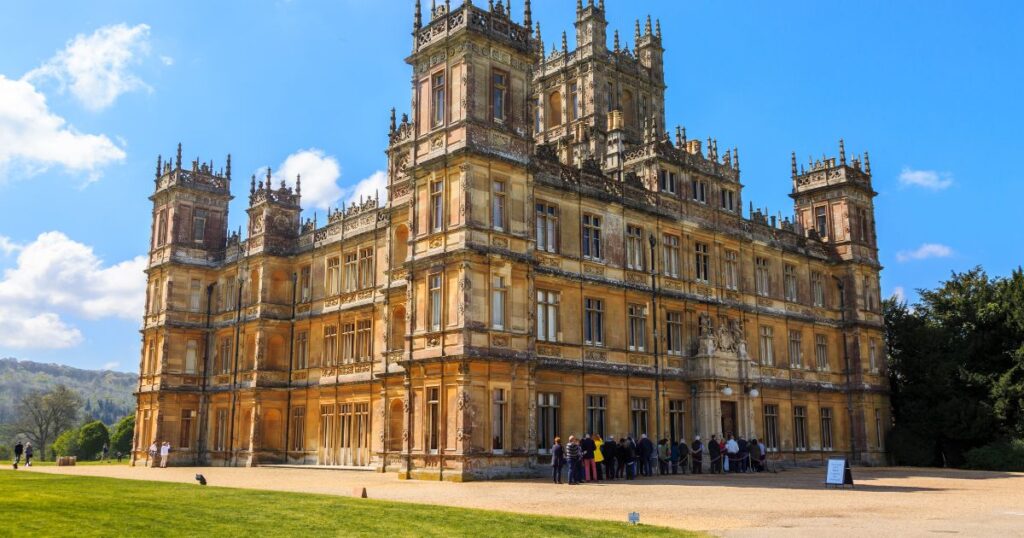
Famous Castle Regions in England
England’s castles are spread across every corner of the country, but a few regions stand out for their density, historical significance, and architectural variety. These areas offer ideal starting points for travelers planning multi-castle itineraries.
London & the Home Counties (Royal Palaces & Tudor Splendor)
The region surrounding London contains some of England’s most iconic castles and palaces — from royal residences to Tudor masterpieces. This area showcases England’s transition from medieval fortresses to ceremonial palaces designed for power and display. Highlights include the Tower of London, Hampton Court Palace, Windsor Castle, and the moated elegance of Hever Castle. Excellent transport links make it one of the easiest regions to explore.
Northumberland (Coastal Fortresses & Border Strongholds)
Northumberland boasts the highest concentration of castles in England, shaped by centuries of conflict with Scotland. Ruins cling to dramatic headlands, medieval halls crown windswept beaches, and mighty fortresses dominate market towns. Castles such as Bamburgh, Dunstanburgh, Warkworth, and Alnwick define the region’s rugged, cinematic landscape. This is one of England’s most atmospheric areas for castle lovers.
Yorkshire (Medieval Power Bases & Vast Strongholds)
Yorkshire’s castles reflect the region’s wealth and strategic importance in medieval England. Expect imposing keeps, sprawling curtain walls, and fortified market towns. Sites like Middleham, Bolton, Helmsley, and Scarborough reveal England’s northern military history, while York’s Clifford’s Tower connects castle architecture with the city’s layered past. Yorkshire is ideal for travelers seeking classic medieval fortresses surrounded by lush countryside.
Kent & the South Coast (Ancient Gateways & Clifftop Castles)
Known as the “Gateway to England,” Kent’s coastal castles defended the realm for centuries. Dover Castle – often called the “Key to England” – anchors the region with one of the country’s most comprehensive defensive complexes. Nearby Deal and Walmer Castle represent Henry VIII’s artillery fort program, while Bodiam Castle further inland offers a postcard-perfect medieval setting complete with a dramatic moat.
The Midlands (Royal Residences & Architectural Innovation)
Centrally located, the Midlands blends medieval power centers with ornate Renaissance and later-period architecture. Warwick Castle and Kenilworth Castle dominate the region, telling stories of royal intrigue and siege warfare. Further afield, the romantic ruins of Ashby de la Zouch or the unique history of Berkeley Castle offer something for every traveler. This region is perfect for pairing castles with Shakespeare Country and charming historic towns.
Cotswolds & Oxfordshire (Manor Houses & Fortified Homes)
Here, England’s castle story softens into fortified manors, stately homes, and medieval residences that evolved into aristocratic estates. Broughton Castle and Sudeley Castle exemplify the blend of domestic comfort and defensive architecture. The rolling countryside and honey-stone villages make this region ideal for travelers who want a gentler, more scenic castle experience.
Southwest England (Myths, Legends & Dramatic Ruins)
Rugged coastlines and Arthurian mythology define castle exploration in Cornwall and Devon. Tintagel Castle delivers some of the most dramatic scenery in England, perched high above the crashing Atlantic. Dartmouth, Totnes, and Restormel Castles reveal medieval military and administrative life in the southwest. This region is perfect for history buffs who enjoy a mix of archaeology, folklore, and sweeping landscapes.
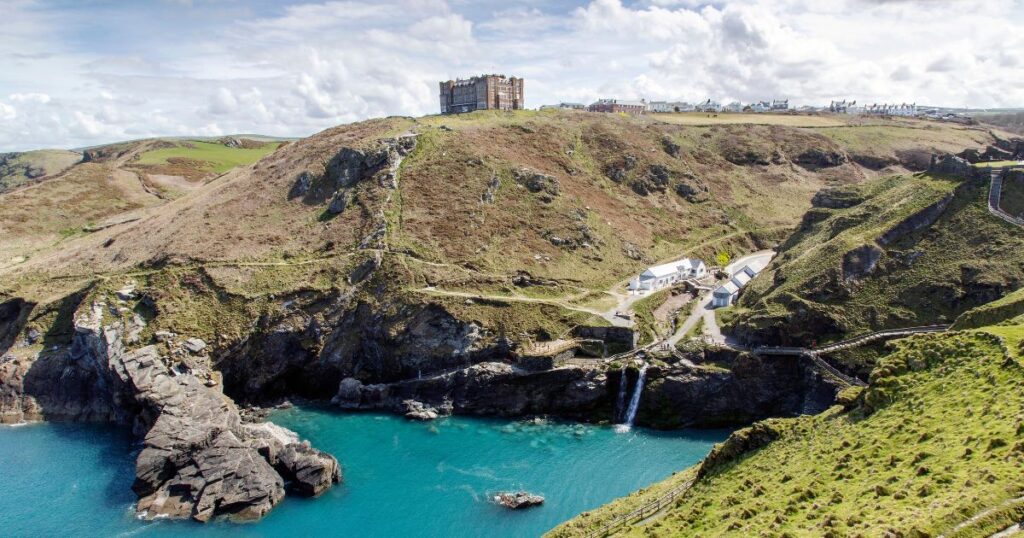
East Anglia (Fortified Towns & Norman Power Centers)
With its strong medieval heritage, East Anglia features formidable Norman stone keeps and coastal fortifications. Castles such as Framlingham, Orford, Castle Rising, and Colchester (one of the oldest Norman keeps in Europe) showcase early medieval engineering and political influence. It’s a fascinating region for visitors intrigued by the earliest phases of English castle building.
Top Castles to Visit in England
Windsor Castle
The oldest and largest occupied castle in the world, Windsor remains a working royal residence with magnificent State Apartments, St. George’s Chapel, and centuries of ceremonial tradition.
Tower of London
A UNESCO World Heritage Site famed for its Norman White Tower, medieval ramparts, royal prison history, and the Crown Jewels. One of England’s most important historic fortresses.
Dover Castle
Known as “The Key to England,” Dover features medieval walls, a reconstructed Great Tower, wartime tunnels, and commanding views over the English Channel.
Warwick Castle
A medieval fortress transformed into a grand stately residence, Warwick is famous for its towers, armory, riverside gardens, and immersive historical presentations.
Hampton Court Palace
Henry VIII’s iconic Tudor palace, later expanded by the Stuarts. Visitors explore Tudor kitchens, the Great Hall, Baroque apartments, the Maze, and world-class gardens.
Blenheim Palace
A monumental Baroque estate and birthplace of Sir Winston Churchill. Blenheim’s gilded State Rooms, Capability Brown parkland, and richly decorated interiors showcase aristocratic grandeur on an epic scale.
Chatsworth House
One of England’s finest stately homes, known for its lavish interiors, Old Master paintings, sculpture collection, and beautifully landscaped Peak District gardens. A longtime favorite of filmmakers and literature fans.
Castle Howard
A spectacular Baroque country house famed for its domed central block, ornate rooms, lakes, fountains, and extensive parkland. Instantly recognizable from Brideshead Revisited and numerous period dramas.
Leeds Castle
A picture-perfect castle located on an island in a lake. Once a royal residence of six medieval queens, it combines medieval fortifications with elegant modern interiors and gardens.
Alnwick Castle
A medieval stronghold still lived in by the Duke of Northumberland. Famous for its film roles (including Harry Potter), its lavish State Rooms, and its renowned contemporary gardens.
Highclere Castle
Best known as the filming location of Downton Abbey, Highclere is a Victorian masterpiece with grand interiors, landscaped grounds, and Egyptian exhibition galleries.
Other Noteworthy English Castles
Sudeley Castle
A romantic Cotswolds estate tied to Katherine Parr, featuring exquisite gardens and a charming chapel.
Rochester Castle
One of England’s finest Norman keeps, towering above the River Medway with dramatic medieval architecture.
Bolsover Castle
A whimsical 17th-century “fantasy castle” with riding house demonstrations and panoramic views over Derbyshire.
Deal Castle
A fascinating Tudor artillery fort built during Henry VIII’s coastal defense program, showcasing star-shaped symmetry.
Middleham Castle
A powerful Yorkshire stronghold once home to Richard III, offering atmospheric ruins and sweeping Dales scenery.
Arundel Castle
A restored medieval-to-Victorian ducal palace with lavish interiors and impressive ramparts.
Castle Gardens & Landscapes in England
England’s castles are not only architectural treasures – many are surrounded by some of the most beautiful and historically significant gardens in Europe. These landscapes reflect the tastes of monarchs, aristocrats, and visionary gardeners, evolving over centuries from defensive clearings to grand ornamental parks. Today, castle gardens offer travelers sweeping views, peaceful walking paths, and immersive connections to England’s horticultural heritage.
Tudor Gardens & Early Formal Landscapes
In the 16th century, English castle gardens were heavily influenced by Tudor aesthetics: symmetry, enclosed spaces, and practical plantings. Knot gardens, herb beds, and orchard walks were common, often walled to protect from animals and wind.
Hampton Court Palace is the finest example, featuring formal compartments, geometric designs, and one of the earliest surviving Renaissance-inspired gardens in England.
Elizabethan & Jacobean Decorative Gardens
By the late 1500s, castle gardens emphasized display, symbolism, and entertainment — reflecting the wealth of aristocratic families and the tastes of Queen Elizabeth I’s court.
Kenilworth Castle’s recreated Elizabethan garden, originally built by Robert Dudley to impress the queen herself, showcases fragrant plants, ornate obelisks, and a striking marble fountain, offering a rare glimpse into the garden culture of the era.
Baroque Grandeur & Sculpted Landscapes
The 17th and 18th centuries saw a shift toward broad, dramatic perspectives and carefully sculpted topography. Sweeping avenues, parterres, terraces, and reflective water features defined this period. Hampton Court’s later Baroque additions and the regal terraces at Windsor Castle illustrate the era’s preference for order, control, and spectacle.
Capability Brown & the English Landscape Garden
In the 18th century, England pioneered a new garden style — the naturalistic “English landscape garden.” Instead of rigid symmetry, designers like Lancelot “Capability” Brown created fluid, painterly scenes using rolling lawns, grottoes, lakes, and artfully placed trees.
Blenheim Palace is the most famous example, but numerous castle estates, including Warwick and Sudeley, adopted aspects of this style, creating romantic vistas that still define their settings today.
Victorian Extravagance & Botanical Collecting
The 19th century brought bold flower borders, exotic plant specimens, and highly decorative glasshouses inspired by global exploration. Many castle gardens were reimagined to highlight vivid color, structural planting, and horticultural innovation.
Arundel Castle’s gardens, featuring themed spaces, fountains, and a dramatic rooftop glasshouse, represent Victorian creativity at its peak.
Modern Castle Gardens & Seasonal Displays
Today, castle gardens across England combine historical preservation with modern design principles. Visitors can explore:
- Woodland walks with spring bluebells
- Rose gardens in peak summer bloom
- Water features, sculptures, and reflective pools
- Riversides and lakeside lawns ideal for picnics
- Carefully restored heritage plantings
Leeds Castle, Hever Castle, and Sudeley Castle are particularly renowned for their seasonal displays, combining vibrant color with historic charm.
These landscapes add depth, atmosphere, and beauty to England’s castle experience – inviting travelers not just to explore the architecture, but to linger, wander, and enjoy the exquisite artistry of centuries past.
Castle Restoration & Preservation in England
England’s castles have endured centuries of conflict, weathering, neglect, and rebuilding. Today, an impressive nationwide effort preserves these extraordinary structures, balancing historical accuracy with modern visitor needs. Organizations such as English Heritage, the National Trust, and private estate owners invest heavily in archaeological research, structural conservation, and garden restoration to ensure these landmarks survive for future generations.
Preservation work ranges from stabilizing medieval curtain walls to reconstructing Tudor-era gardens with historically accurate plants. Many castles undergo ongoing masonry repairs, drainage improvements, and roof restorations to prevent long-term deterioration. Sites like Kenilworth Castle and Dover Castle have benefited from detailed archaeological projects that not only conserve the structures but also uncover new insights into medieval life. Visitor-friendly enhancements – accessible pathways, interpretive displays, and carefully restored interiors – ensure that education and enjoyment go hand in hand with conservation.
As climate change brings new challenges, especially to coastal fortresses like Dunstanburgh and Bamburgh, preservation teams are increasingly focused on erosion mitigation, environmental monitoring, and sustainable tourism practices. Castle restoration in England is a living, evolving process – one that requires constant adaptation while honoring the architectural heritage of the past.
For more on the preservation and stewardship of England’s castles, visit English Heritage’s official website.
Notable Figures & Events
These are some historically notable figures and events tied to England’s most significant castles:
- William the Conqueror – Commissioned the Tower of London and launched England’s widespread castle-building boom after 1066.
- Henry II – Strengthened royal castles and built powerful keeps such as at Dover, reinforcing centralized authority.
- King John – Lost control of numerous strongholds during the First Barons’ War, including Rochester Castle after its legendary siege.
- Eleanor of Aquitaine – Influenced the development of royal residences and the cultivation of courtly culture within castle walls.
- Edward I – Known for his sophisticated military architecture; though more associated with Wales, he reshaped English defense strategy.
- Robert Dudley – Recreated Kenilworth Castle’s gardens to impress Elizabeth I during her royal visit in 1575.
- Henry VIII – Revolutionized castle design with his coastal artillery forts, including Deal, Walmer, and St Mawes.
- The English Civil War (1642–1651) – Led to the “slighting” (intentional destruction) of many castles, drastically altering England’s medieval landscape.
- Queen Victoria – Inspired the 19th-century Gothic Revival, which led to the romantic restoration of castles such as Windsor and Arundel.
These individuals and events shaped the castles we see today – from foundational military engineering to dramatic episodes of war, rebellion, and royal transformation.
Castles in Modern English Culture
Castles continue to play a vivid role in modern English culture. Many English castles appear in films, television, documentaries, and photography, inspiring worldwide fascination.
- Alnwick Castle – Harry Potter, Downton Abbey
- Dover Castle – WWII films & historical dramas such as The Other Boleyn Girl
- Warwick Castle – reenactments and medieval festivals
- Highclere Castle (not a medieval castle, but castle-styled) – Downton Abbey
- Tintagel – a staple of Arthurian retellings
- Castle Howard – Brideshead Revisited
- Blenheim Palace – Numerous films including The Young Victoria & Spectre (James Bond)
- Chatsworth House – Numerous films & series including The Duchess & Peaky Blinders
English castles also inspire contemporary writers, historians, and artists, helping shape popular imagination around medieval and Tudor history. From historical fiction to children’s books and video games, castles remain symbolic of England’s past – places where stories of rebellion, romance, and royalty come to life.
In tourism, castles are integral to England’s national brand. Millions of visitors explore these sites each year, generating support for local communities and funding ongoing preservation. Seasonal events – from medieval reenactments to Christmas markets — ensure that castles remain lively, relevant, and deeply embedded in cultural life.
Cultural Traditions Linked to Castles
English castles are entwined with centuries of customs, rituals, and seasonal celebrations that continue to shape local culture today. These traditions – many rooted in medieval court life, royal ceremony, and regional folklore – bring castles to life in ways that go far beyond their stone walls.
Courtly Rituals & Royal Pageantry
Castles once served as theatrical stages for royal authority: grand entrances, processions, state banquets, masques, and jousts that displayed wealth and hierarchy. Today, the echoes of these traditions survive in modern ceremonies and events.
Examples: Investitures at the Tower of London, state occasions at Windsor Castle, and historical reenactments at sites like Kenilworth and Dover.
Seasonal Festivals & Community Celebrations
Many English castles host annual events rooted in medieval and Tudor tradition. These vibrant programs bring castle courtyards and great halls to life. These traditions preserve local heritage while offering immersive, family-friendly experiences. Key seasonal experiences include:
- Summer jousting tournaments (Kenilworth, Hever Castle)
- Harvest fairs featuring artisans, falconry, and costumed performers
- Christmas events with carol singers, illuminated gardens, and decorated halls
Historic Gardens & Outdoor Rituals
Castle gardens have long been settings for entertainment, poetry, royal promenades, and outdoor games. Today, these landscapes continue to host cultural events that draw on centuries of outdoor tradition.
Examples: Garden shows at Hampton Court Palace, outdoor theater at Leeds Castle, and summer concerts at Castle Howard.
Folklore, Legends & Ghost Traditions
Few places in England have inspired as many myths as its castles. Their long histories, dramatic settings, and ancient corridors make them natural backdrops for storytelling and ghost lore. These famous legends make for things like fun and popular night tours, storytelling events, and October ghost walks.
- Anne Boleyn’s ghost at the Tower of London
- The “Brown Lady” of Raynham Hall
- Treasure legends linked to Corfe Castle
Culinary Traditions & Historic Kitchens
Food history is an important part of the castle experience. Many historic kitchens now feature demonstrations and tastings that revive medieval and Tudor culinary rituals. Programs often include things like this, and offer a flavorful look into historic dining and everyday life:
- Tudor cooking demonstrations
- Mead or ale tastings
- Estate-grown produce served in castle cafés
Bringing It All Together
These cultural traditions transform England’s castles from static monuments into dynamic living heritage sites – places where history is performed, celebrated, and experienced through food, festivals, stories, and community gatherings.
Planning Your Castle Tour in England
Planning a castle-themed trip through England is surprisingly simple thanks to excellent transport links and clusters of historic sites within short distances of one another. Here are some of the most rewarding routes to help shape your itinerary:
Royal & Tudor Highlights (London + Surroundings)
Tower of London – Hampton Court Palace – Windsor Castle – Leeds Castle – Hever Castle
South Coast & Clifftop Castles Route
Dover Castle – Deal Castle – Walmer Castle – Bodiam Castle – Arundel Castle
Yorkshire Medieval Strongholds Route
York (Clifford’s Tower) – Helmsley Castle – Middleham Castle – Bolton Castle – Scarborough Castle
Northumberland Coast Fortress Trail
Alnwick Castle – Warkworth Castle – Dunstanburgh Castle – Bamburgh Castle – Lindisfarne Castle
Midlands & Shakespeare Country Route
Kenilworth Castle – Warwick Castle – Stratford-upon-Avon – Sudeley Castle
Southwest Legends & Arthurian Landscapes
Tintagel Castle – Restormel Castle – Dartmouth Castle – Totnes Castle
Cotswolds & Heart of England Castles Route
Warwick Castle – Kenilworth Castle – Broughton Castle – Sudeley Castle – Berkeley Castle
Lake District & Northern Borders Route
Lancaster Castle – Brougham Castle – Penrith Castle – Carlisle Castle – Barnard Castle
Historic East Anglia & Coastal Castles Route
Framlingham Castle – Orford Castle – Norwich Castle – Castle Rising – Colchester Castle
Family-Friendly Castle Adventure Route
Warwick Castle – Alnwick Castle – Leeds Castle – Hever Castle – Bodiam Castle
Practical Tips For Visiting Castles In England
Exploring castles in England offers a remarkable mix of medieval fortresses, Tudor palaces, moated manors, and dramatic coastal ruins. These practical tips help you navigate transportation, crowds, weather, and on-site logistics so you can enjoy each historic site at its best.
Trip Planning Essentials
Regions to consider:
Northumberland (coastal fortresses), Kent (moated royal favorites), Yorkshire (medieval strongholds and cliffside ruins), and the Midlands/Cotswolds (grand palaces + romantic ruins). London-area travelers can easily access Windsor, Hampton Court Palace, and the Tower of London.
Getting around:
Trains are excellent for major castles like Windsor, Hampton Court, Warwick, and Dover. Rural sites in Northumberland, Yorkshire, and the Southwest often require a car. Coastal castles may involve short hikes from parking areas.
When to visit:
May–October offers the best weather and longest days. Winter brings reduced hours or closures at smaller sites, though major castles (Windsor, Tower of London, Hampton Court Palace) remain open year-round.
Book ahead:
Reserve early for the Tower of London, Hampton Court Palace, Windsor Castle, Dover Castle, Warwick Castle, and Alnwick Castle — all of which sell out in high season.
On-Site Advice & Insider Insights
Prepare for varied terrain:
Expect cobblestones, towers, grassy slopes, and uneven walkways. Good footwear is essential, especially at Tintagel, Corfe Castle, Bamburgh, and other cliffside or hilltop sites.
Expect changeable weather:
Bring layers and waterproofs. Even summer days can shift quickly — helpful for both comfort and photography.
Photography notes:
Interiors may restrict flash. Exterior views are often the stars. Best shots include Bamburgh at sunrise, Corfe in morning mist, Dover from the clifftops, and Hampton Court’s gardens and courtyards.
Accessibility:
More accessible castles include Hampton Court Palace, Windsor Castle, and Leeds Castle. Less accessible are steep or ruinous sites like Tintagel and Corfe Castle.
Food & facilities:
Large castles offer cafés; rural ruins often have no amenities. Many estates (Leeds, Hampton Court, Warwick) allow picnics in designated garden areas.
Frequently Asked Questions About Castles In England
How many castles are there in England?
More than 4,000 sites, including ruins, fortresses, and palatial estates.
What is the most famous castle in England?
Windsor Castle, home to the British royal family and 1000 years of royal history. Windsor is the oldest and largest occupied castle in the world.
Which region in England has the most castles?
Northumberland is often considered the most castle-rich region in Europe.
Can you stay overnight in an English castle?
Yes – many castles and manor-style properties offer luxury stays.
Are English castles open year-round?
Major castles stay open year-round; many rural ruins reduce hours in winter.
Are English Heritage and National Trust sites the same?
No. Both protect historic places, but they are separate organizations. English Heritage manages many major castles (like Dover and Tintagel), while the National Trust oversees estates such as Bodiam and Corfe Castle.
What is the oldest castle in England?
The Tower of London, founded in the 1070s by William the Conqueror, is often considered the earliest major stone castle. Some earlier earthwork fortifications exist, but the Tower is the oldest substantial structure still standing.
What’s the best area for visiting multiple castles in one trip?
Kent (“The Garden of England”) and Northumberland are two of the most castle-rich regions. Both offer clusters of major sites within easy driving distance.
Conclusion
Exploring castles in England is a captivating journey through nearly a millennium of history. From Norman keeps and Tudor palaces to dramatic cliffside ruins and Victorian revival estates, each site offers a unique story shaped by monarchs, battles, romance, rebellion, and cultural transformation. Whether you’re standing atop Dover’s battlements, wandering the gardens of Leeds Castle, or photographing Corfe Castle at sunrise, England’s castles invite you to experience their enduring legacy firsthand.
These magnificent structures remain central to English identity – not just preserved monuments, but vibrant places filled with festivals, exhibitions, gardens, and living history. Wherever your castle travels lead, England offers endless discovery, breathtaking beauty, and a deeper appreciation for the people and events that shaped the nation.
